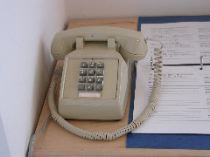 “Open” at Arcadia is a show of stealth works. (See my previous post for preamble.) Some of the art looks suspiciously like real world objects. And some of the real world objects, like the telephone on the utility shelf near the door, are shape-shifters — doing time in the real world then switching to the world of art when some action occurs.
“Open” at Arcadia is a show of stealth works. (See my previous post for preamble.) Some of the art looks suspiciously like real world objects. And some of the real world objects, like the telephone on the utility shelf near the door, are shape-shifters — doing time in the real world then switching to the world of art when some action occurs.
I like the idea of multi-tasking objects — cars that people use as “offices,” rocks that become doorstops. Like people, the objects don’t lose their identity when they switch gears.
This separates them in my mind from Duchamp’s readymades which for all practical purposes have stopped being multi-tasking objects and are subsumed under their new identity as art objects.
Getting back to the phone, (pictured above).
By virtue of artist George Brecht’s conceptual conceit, the real phone is a real piece, “Three Telephone Events,” 1961. There’s a recipe by which the phone becomes transformed and I won’t bore you with details just mention that you can turn your own phone into a Brechtian art object if you follow the instructions.
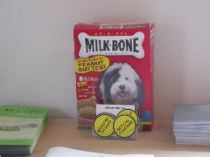
Here’s one object that maintains its real world roots but becomes a symbol to boot — the box of dog bones. It can’t be art here in this show — it has too much color.
But it’s a symbolic pointer to the high frequency audio piece by Dave Allen, “For the Dogs: Satie…” Allen, you may remember, is the artist whose intervention with birds and piano music was at Arcadia last year. See my post and Libby’s post.) The piece here was made specifically to be heard by dogs, who came out at the opening in a little pack with their owners. I was told by the gallery’s Jessica Bakula that one dog, a pug if memory serves, enjoyed the music so much it pulled its owner away from the food table and back to hear more of the high frequency music!
Now there’s an art critic for you.
In front of the box is a piece by James Mills. The small, round, yellow and black stickers, which announce themselves as “Official Souvenir Sticker” are there for the taking. It’s another example of silly art in this show.
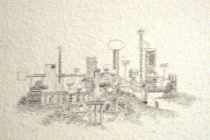
By the time I found Randall Sellers‘ “Untitled Wall Drawing” I was ready for some real art. Here it was, all two square inches of it. I am most sorry that my hand shook when I took the picture of the rather high-placed drawing because I failed to capture the crispness of the work put on a nubbly wall by an artist who took four days to complete the thing using .0000 pencils. This is an outstanding work. It’s not stealth. It’s not nothing. It’s an amazing Sellers piece and if you’re still on the fence about this show, this is the work that will make the trip a delight.
Next to Sellers’ piece is more art. Faint to be sure. It’s Sol LeWitt‘s “Wall drawing No. 62,” 1971. (detail below)
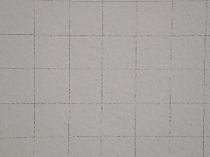
The piece is a large pencilled grid (applied to the wall by local artist Tristin Lowe, Bakule told me). The work is so subtle it disappears when you’re more than two feet away from it. Nice.
There are lots more works in this show but this post is getting way too long so I’ll tell you about a few more then let it go.

Roxana Perez-Mendez‘s rusting steel wool piece “Hongo,” (I’m giving this away, sorry) is under the utility table. (right is detail)
The dogs-eye level piece wins the sexy art award in a show of otherwise non-body referencing stuff.
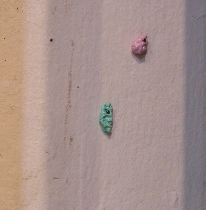
Angela Bulloch‘s “Chewed Gum,” 1998, (left is detail) eight pieces scattered around the room, each one nailed to the wall like a kind of medieval indulgence gone wrong — an anti-trophy — could be considered body-byproduct art. I consider it pretty silly.
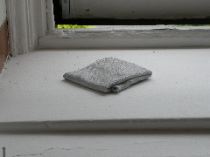
On the other hand, Bill Walton‘s “Bright Sill” 2004, is heart-stoppingly beautiful (right).
Perhaps it’s the humbleness of the piece which looks like a work cloth folded carefully by a worker proud of the job just finished. Or perhaps its the fact of it’s being washed by the Vermeerish light coming in that window. Either way, the piece is a love.
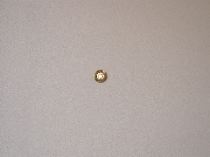
The peephole piece, “Lure” by Ivan Jurakic (left) is a danger. I scalded my eyeballs trying to peek at what’s behind (not recommended). I suppose it could be heaven behind that wall but since I don’t care about that, the work left me cold.
I’ll let Jeremiah Misfeldt have the last word. It seems appropriate for his curse piece, “unearthly pronouncement and celestial means,” 2004, which, the checklist says, gets reactivated daily at noon.
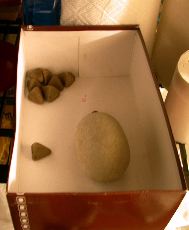
What that means is unclear. Whether Misfeldt stops his business at noon and pronounces the curse or whether you can set a curse on an automatic timer to go off again and again I don’t know. But in case you’re worried, there’s an antidote in the gallery office’s closet — special rocks that haven’t seen the light of day for four years. (right) Touch the big rock and you’re out from under. (The little triangle-shaped rocks are for gallery staff to carry with them when they enter the gallery.)
The idea of serious curse art (there’s also prayer art, but you’ll have to go see for yourself) is laugh out loud funny. But in the context of this show, I buy it.









